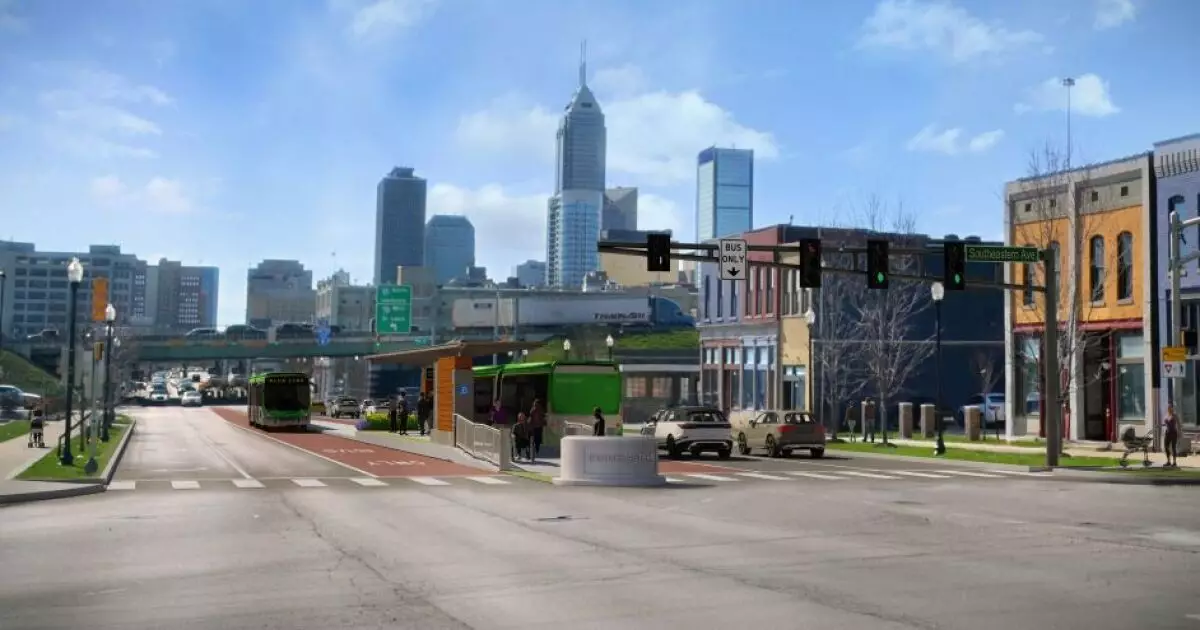A recent $125 million bond sale aimed at funding the Blue Line Bus Rapid Transit (BRT) project has raised significant concerns among Indianapolis residents and taxpayers. The Indianapolis Local Public Improvement Bond Bank has initiated this funding campaign for IndyGo, the city’s public transportation authority. While proponents argue that this move will enhance mobility and convenience in a growing metropolis, it’s essential to scrutinize the potential implications of such large-scale financial maneuvers.
At first glance, the allocation of these funds to create a 24-mile rapid transit route from Indianapolis International Airport to downtown seems logical. However, one must consider why this project, despite its promising intentions, could ultimately lead to adverse fiscal outcomes. The overreliance on bonds, rated AA-minus by S&P, may present more risks than rewards, especially in a fluctuating market environment where bond deals are often pulled in a volatile economic climate, as seen recently.
The Impact of External Economic Forces
One cannot ignore the harsh realities of the economic landscape impacting municipal bonds. Recent market conditions have seen rising municipal yields driven largely by external pressures, including tariffs that increase costs and lead to uncertainty. The decision to postpone the pricing of these bonds reflects not just prudent financial management, but also an alarming awareness of the market’s inherent instability.
The truth is that issues like these don’t arise in a vacuum. The financial repercussions of relying on unpredictable municipal bond markets can ripple through the economy, hurting not just the IndyGo project but potentially putting taxpayer funds at risk. It raises the question: Are we really in a position to gamble $125 million on a transit scheme when the economic foundations seem shaky?
Rethinking Transit Priorities
While the push for transit improvements is generally laudable, the wisdom of pursuing a Rapid Bus Transit line may be questionable. This will be IndyGo’s third BRT line, and a critical analysis reveals essential questions about funding and return on investment. Why are we not prioritizing more fundamental issues, such as improving the existing infrastructure and ensuring the reliability of current services?
Creating new BRT lines may appear progressive, but considering the recent history of fare recovery ratios—dropping to about 5% from a pre-pandemic 9.5%—any investment becomes riskier. The post-COVID recovery phase, as ridership hovers around 75% of pre-pandemic levels, begs further scrutiny. Do we truly need to invest heavily in expansion while the current system is still struggling? A well-functioning transit system should take precedence over ambitious extensions that promise more than they can deliver.
Financial Risks for Indianapolis Residents
One of the more concerning aspects of this bond sale is the financial burden it places on taxpayers in Marion County. Principal and interest on the bonds will be paid from a special fund fed by a dedicated local income tax. This creates a reliance on a tax structure that is inherently vulnerable to the ups and downs of the economy. Residents must question whether they are prepared to shoulder this burden, especially when the reliability of revenue streams appears to fluctuate.
Moreover, the collateralized nature of these bonds through a debt service reserve fund can present challenges. What happens if these reserves fall below requirements? The stated plans to restore such deficiencies could lead to political headaches or funding shortfalls in critical areas. This precarious balancing act raises the specter of potential budget cuts in public services to maintain bond payments.
Long-term Implications of Debt Accumulation
With the addition of these new bonds, IndyGo’s long-term debt will balloon to approximately $209.1 million. Such an accumulation cannot simply be viewed through the lens of immediate improvements; it represents a long-term financial commitment that could strain Indianapolis’s budget in the years to come. Will the promised benefits of increased transit reliability and accessibility truly materialize, or will this be a case of pouring good money after bad?
As more cities are discovering, unsustainable debt levels can lead to difficult financial decisions. The burden of long-term bonds can tie the hands of local governments, limiting their ability to address pressing social services, healthcare, and education needs. Can Indianapolis afford to put all its eggs in the transit basket when other areas of necessity face looming crises?
A Critical Road Ahead
In the end, the proposed $125 million bond sale for the Blue Line BRT project encapsulates a broader struggle between ambitious urban planning and the stark realities of economic sustainability. Each step forward should be critically assessed for its ability to genuinely benefit the city and its residents, rather than serve as a superficial remedy that may lead to greater challenges in the future. If the leadership fails to prioritize financially prudent strategies over grand visions, the risk of financial calamity looms larger than ever.

